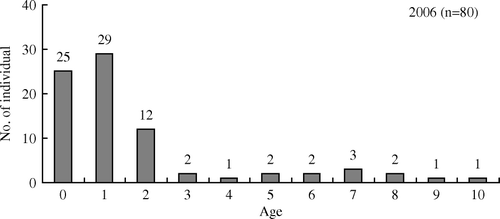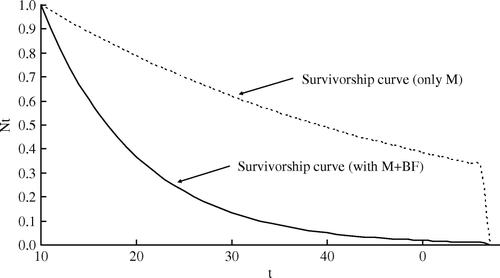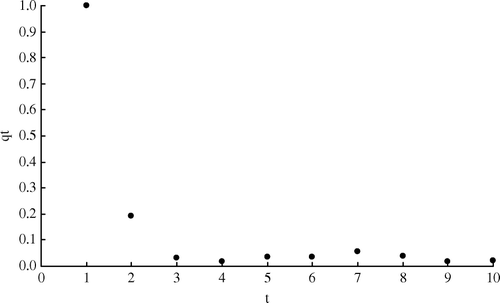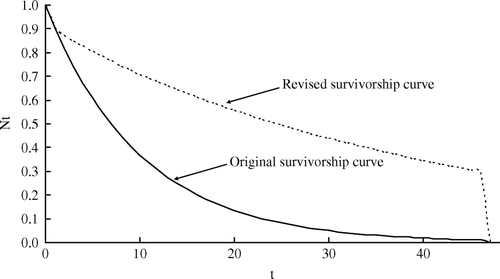Abstract
Population ecological characteristics of growth and mortality play an important role in understanding the population dynamics of marine mammals. The instantaneous coefficients of natural and bycatch mortality were estimated for minke whales (Balaenoptera acutorostrata) in Korean waters using a population assessment model composed of bycatch and abundance data. The survivorship curve of this population was fitted to the data, and then the curve was revised using age-specific relative bycatchability coefficients (q t ). Instantaneous coefficients of natural and bycatch mortality of minke whales were estimated as 0.024/year and 0.076/year, respectively, and from this the survival rate was estimated as 0.905. This estimated survival rate was comparable to other cetaceans in other regions. The q t for this population ranged from 0.020 to 0.193. The revised survival rates were higher when the q t was taken into account. The mortality coefficient, survival rate, q t and survivorship curves had not previously been determined for minke whale in this area. This estimate could serve as fundamental information to assess the status of this population and for conservation and rational management.
Introduction
Minke whales (Balaenoptera acutorostrata) are widely distributed in most oceans of the world including Korean waters (Jefferson et al. Citation1993). It is thought that there are two stocks of minke whales in the western North Pacific, the J stock (East Sea–Yellow Sea–East China Sea stock) and the O stock (Okhotsk Sea–West Pacific stock) (IWC Citation1983). According to a recent analysis, the abundance of the J stock was estimated at 7600 individuals (coefficient of variation; CV=0.4) (IWC Citation1984), and is considered the most abundant baleen whale in Korean waters. Several studies were conducted on Korean minke whales, and included analysis of stock structure (Park et al. Citation2004), abundance (Gong Citation1988; Sohn et al. Citation2001; Park et al. Citation2009), bycatch (Kim et al. Citation2004; Kim Citation2008; Song et al. Citation2010), and age structure (Na Citation2005).
This stock was seriously damaged by intensive commercial whaling in the western North Pacific until the moratorium on commercial whaling was imposed in 1986. Unfortunately, since the moratorium, human-induced mortality of minke whales still continuously occurs in Korean waters (Kim Citation1999, Citation2008; Kim et al. Citation2004). According to reports, approximately 100 minke whales per year were bycaught on average (Kim et al. Citation2004; Kim Citation2008). Furthermore, based on simulations this stock is predicted to become extinct over the next few decades at this rate (100–150 individuals/year) (Baker et al. Citation2000).
Large quantities of accurate data on the population dynamics of marine mammals are needed for effective conservation and management. Population ecological characteristics such as the survival rate can play an important role in understanding the population dynamics of marine mammals (Barlow and Boveng Citation1991; Fujiwara and Caswell Citation2001). However, the mortality coefficient, survival rate, age-specific relative bycatch-ability coefficients and survivorship curves for minke whales in Korean waters have not been previously investigated.
The survival rate of marine mammals such as the minke whale can be estimated using age composition data of death individuals from catch and bycatch (Caughley Citation1966; Ohsumi Citation1979; Chapman Citation1983) or age composition data of living individuals based on photo-identification (Barlow and Boveng Citation1991; Barlow and Clapham Citation1997). For the minke whale, specifically in the southern hemisphere, several studies estimated instantaneous mortality ranging from 0.06 to 0.15/year (Ohsumi Citation1979; Chapman Citation1983). Although several studies have reported the bycatch of minke whales in Korean waters (Kim Citation1999, Citation2008; Kim et al. Citation2004), there was little effort to investigate population ecological characteristics using these data. Only Na (Citation2005) reported the age structure of minke whales using bycatch data obtained between 2002 and 2004 in Korean waters.
The objective of this study is to estimate the instantaneous coefficients of natural and bycatch mortality for minke whales in Korean waters, and to determine the survivorship curve of this population using age-specific relative bycatchability coefficients (q t ). This includes mechanisms of availability, encounterability, and selectivity for fishing gear.
Materials and methods
To estimate mortality coefficients for minke whales in Korean waters, we used data on bycatch and abundance of minke whales in this area from five years (2000, 2002, 2003, 2005 and 2006) () (Kim et al. Citation2004; Kim Citation2008; Park et al. Citation2009). Generally, the numbers of a cohort at time t are given by the following equation:
Figure 1. Bycaught sites (circles) of minke whales in Korean waters. The survey block (thick line) depicts the sighting and bycatch survey area.
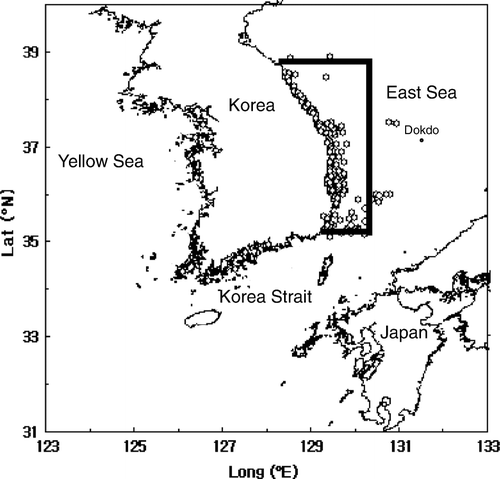
The age-specific relative bycatchability coefficients (q t ) for minke whales in this area were estimated from the following equations:
We fitted survivorship curves considering only natural mortality (N t =N 0 e–Mt ), or considering both natural and bycatch mortality (N t =N 0 e–(M+BF)t ). We then revised the second curve using the q t (N t =N 0 e–(M+qtBF)t ). We estimated a survivorship curve using the catch curve method based on the assumption that (1) the survival rate for all age classes is constant; (2) the bycatch for each age class is proportional to abundance for each age class; (3) the recruitment for each age class is constant; (4) the estimation of age is accurate.
Results
Mortality coefficient and survival rate
The instantaneous coefficient of natural mortality (M) for minke whales in this area was estimated at 0.024/year using the value of β (=2.675; Wang Citation1985), K (=0.167; Na Citation2005), t mb [=C i (=0.302; Zhang and Megrey Citation2006) t max (=47; Trites and Pauly Citation1998)=14.194] and t 0 (t 0 is assumed as 0). The instantaneous coefficient of bycatch mortality (BF) was estimated at 0.076/year using the mean value of BC (=73 individuals; Kim et al. Citation2004; Kim Citation2008) and N (=959 individuals; An et al. Citation2009) during specific periods. As a result, the instantaneous total mortality coefficient (Z) was estimated at 0.100/year using the value of M (=0.024/year) and BF (=0.076/year). Also, the overall survival rate (S) was estimated as 0.905 using the value of Z (=0.100/year).
Survivorship curve
The overall survivorship curve for this population was similar to that of other marine mammals (Spinage Citation1972) (). As expected, survival rates at all ages on the survivorship curve which considered both natural and bycatch mortality were lower than those of the survivorship curve that considered only natural mortality. However, these survivorship curves have some limitations because of the assumption of a constant age-specific relative bycatchability coefficient.
Age-specific relative bycatchability coefficient (qt)
The q t for this population is shown in . The q t for this population ranged from 0.020 to 0.193. The coefficients at old ages were lower than those at young age. These results suggest the possibility that rates of bycatch in young individuals were higher than those of old individuals.
Revised survivorship curve using qt
The revised survivorship curve for this population using the q t is shown in . Survival rates at all ages are higher on the revised survivorship curve for this population compared to rates using the original survivorship curve ().
Discussion
The estimated survival rate (0.905) and instantaneous coefficient of total mortality (0.100/year) of minke whales in our study were similar to those of minke whale in other regions (). In the southern hemisphere, several studies have shown mortality estimates for minke whales that range from 0.060 to 0.150/year (Ohsumi Citation1979; Chapman Citation1983). The estimated survival rate was generally comparable to those of cetaceans in other regions (). Estimates for individuals younger than 1 year ranged from 0.759 to 0.867 (Wells and Scott Citation1990; Herzing Citation1997; Mann et al. Citation2000; Gabriele et al. Citation2001; Haase and Schneide Citation2001; Kogi et al. Citation2004), and estimates for adult individuals ranged from 0.850 to 0.976 (Ohsumi Citation1979; Chapman Citation1983; Buckland Citation1990; Hersh et al. Citation1990; Olesiuk et al. Citation1990; Wells and Scott Citation1990; Barlow and Clapham Citation1997; Krahn et al. Citation2002; Calambokidis and Barlow Citation2004; Evans and Hindell Citation2004; Verborgh Citation2005). The estimated survival rate was higher than rates for the finless porpoise, which is frequently found in the Yellow Sea of Korea (Park Citation2006). According to a study by Park (Citation2006), the estimated survival rate for finless porpoises in this area was calculated as 0.722. In addition, this estimate was considerably higher than that of fish in this area, such as the chub mackerel (0.275; Choi et al. Citation2004).
Table 1. Estimated survival rates of several cetaceans.
Survival rates and mortality coefficients for marine mammals can be estimated from the age distribution of dead individuals using catch or bycatch data (Caughley Citation1966; Ohsumi Citation1979; Chapman Citation1983), the age distribution of living individuals using photo-identification data (Barlow and Boveng Citation1991; Barlow and Clapham Citation1997), or the population assessment model using abundance data (Horwood Citation1990). Methods using catch or bycatch data are very useful for fish. However, they have limitations for marine mammals because age distribution using these data may not be representative of the whole population, and it is difficult to obtain age structure data (Caughley Citation1966; Ohsumi Citation1979; Chapman Citation1983). Photo-identification is a valuable tool for obtaining this estimate over consecutive years. However, this estimate can be biased because of the instability of marks used to identify individuals (Barlow and Boveng Citation1991; Barlow and Clapham Citation1997). Finally, a population assessment model is not necessary to obtain age structure data (Horwood Citation1990). However, it also has assumptions that confound estimation, for example assuming a constant rate of pregnancy.
The age of minke whales bycaught in this area ranged from 0 to 10 years old (). The majority of dead individuals were less than 2 years old, and old individuals over 10 years old were not bycaught in our study despite the longevity of the minke whale (over 45 years old; Trites and Pauly Citation1998). A possible reason for this characteristic has been reported (Song et al. Citation2010). According to their study (Song et al. Citation2010), it may be related to individuals’ experience with fishing gear. It is also possible that minke whales are spatially segregated according to age, which may increase the bycatchability of certain age classes. Segregation according to age has been reported (Wada Citation1989; Hatanaka and Miyashita Citation1997), and it was demonstrated that young minke whales tend to migrate along coastlines. Finally, this discrepancy might be due to the entrance size of fishing gear, such as set-nets. However, it is still unclear which of these factors are responsible for bias in the size of bycaught minke whales.
Generally, a relatively high mortality rate has been shown to occcur at all ages (Caughley Citation1966). Therefore, the age structure derived from bycatch data in our study is not representative of the whole population when taking into account the longevity of the minke whale. Our survival estimate only covered 10 years, and this time scale may not be adequate for an analysis of the whole population. Further research is needed to estimate the survival rate of the minke whale in Korean waters more accurately, using high-quality data that can be regarded as representative of the whole population.
There are large differences in age- and sex-specific survival rates for marine mammals (Caughley Citation1966; Stolen and Barlow Citation2003). These differences can play an important role in determining the growth of the population (Gaillard et al. Citation1998). Unfortunately, our study did not provide sufficient data on the differences in age- and sex-specific survival rate. Other studies have also had difficulty in obtaining suitable data for estimating these parameters (Olesiuk et al. Citation1990; Barlow and Boveng Citation1991). Further investigation of differences in age- and sex-specific survival rates of the minke whale in this area is needed to assess the status of this population.
Mortality coefficient, survival rate, q t and survivorship curves for minke whales in Korean waters have not been previously investigated, and this is the first attempt to estimate these parameters in this area. This estimate may be considered fundamental information for assessing the status of this population accurately, and for conserving and managing the population effectively.
Human-induced mortality of minke whales, including bycatch, continuously occurs in Korean waters (Kim Citation1999, Citation2008; Kim et al. Citation2004). Although the effect of bycatch on the survival of this population is currently unknown, it is considered a significant threat to minke whales in this area. Further studies should focus on investigating the impact of bycatch on this population, and should examine the effectiveness of mitigation measures to reduce the bycatch of minke whales in this area.
Acknowledgements
We wish to acknowledge the many volunteers who reported the bycatch of minke whales in Korean waters. This work was financially supported by the Cetacean Research Institute of National Fisheries Research and Development Institute, Republic of Korea.
References
- An YR Kim ZG Choi SG Park KJ. 2009 Abundance estimation of common minke whales in the Yellow Sea and the East Sea using the Korean sighting data from 2000 to 2008 with g(0)=1. Paper SC/61/NPM2 presented to the IWC Scientific Committee, May 2009, Madeira, Portugal 4
- Baker , CS , Lento , GM , Cipriano , F and Palumbi , SR. 2000 . Predicted decline of protected whales based on molecular genetic monitoring of Japanese and Korean markets . Proc R Soc Lond B. , 767 : 1191 – 1199 .
- Barlow , J and Boveng , P. 1991 . Modelling age-specific mortality for marine mammal populations . Mar Mamm Sci. , 7 ( 1 ) : 50 – 65 .
- Barlow , J and Clapham , PJ. 1997 . A new birth-interval approach to estimating demographic parameters of humpback whales . Ecol. , 78 : 535 – 546 .
- Buckland , ST. 1990 . Estimation of survival rates from sightings of individually identifiable whales . Rep Int Whaling Comm (special issue). , 12 : 155 – 160 .
- Calambokidis , J and Barlow , J. 2004 . Abundance of blue and humpback whales in the eastern north Pacific estimated by capture-recapture and line-transect methods . Mar Mamm Sci. , 20 ( 1 ) : 63 – 85 .
- Caughley , G. 1966 . Mortality patterns in mammals . Ecol. , 47 : 906 – 918 .
- Chapman , DG. 1983 . Some considerations on the status of stocks of southern hemisphere minke whales . Rep Int Whaling Comm. , 33 : 311
- Choi YM Zhang CI Kim YS BAIK CI Park YC. 2004 Ecological characteristics and biomass of chub mackerel, Scomber japonicus Houttuyn in Korean waters J Kor Soc Fish Res 6 2 79 89 [in Korean]
- Evans , K and Hindell , MA. 2004 . The age structure and growth of female sperm whales (Physeter macrocephalus) in southern Australian waters . J Zool Lond. , 263 : 237 – 250 .
- Fujiwara , M and Caswell , H. 2001 . Demography of the endangered North Atlantic right whale . Nature. , 414 : 537 – 541 .
- Gabriele , CM , Straley , JM , Mizroch , SA , Baker , CS , Craig , AS , Herman , LM , Glockner-Ferrari , D , Ferrari , MJ , Cerchio , S Ziegesar , O . 2001 . Estimating the mortality rate of humpback whale calves in the central North Pacific Ocean . Can J Zool. , 79 : 589 – 600 .
- Gaillard , JM , Festa-Bianchet , M and Yoccoz , NG. 1998 . Population dynamics of large herbivores: Variable recruitment with constant adult survival . Trends in Ecol Evol. , 13 : 58 – 63 .
- Gong Y. 1988 Distribution and abundance of the Sea of Japan-Yellow Sea-East China Sea stock of minke whales Bull Nat Fish Res Dev Agen 41 35 54 [in Korean]
- Haase , PA and Schneide , K. 2001 . Birth demographics of bottlenose dolphins, Tursiops truncatus, in Doubtful Sound, Fiordland, New Zealand—preliminary findings . New Zealand J of Mar Freshwater Res. , 35 : 675 – 680 .
- Hatanaka , H and Miyashita , T. 1997 . On the feeding migration of the Okhotsk Sea-West Pacific stock of minke whales, estimates based on length composition data . Rep Int Whaling Comm. , 47 : 557 – 567 .
- Hersh SL Odell DK Asper ED. 1990 Bottlenose dolphin mortality patterns in the Indian/Banana River system of Florida In : Leatherwood S Reeves RR The bottlenose dolphin London Academic Press 155 164
- Herzing , DL. 1997 . The life history of free-ranging Atlantic spotted dolphins (Stenella frontalis): age classes, color phases, and female reproduction . Mar Mamm Sci. , 13 : 576 – 595 .
- Horwood J. 1990 Biology and exploitation of the minke whale Baton Rouge, FL CRC Press 238
- International Whaling Commission 1983 Report of the Sub-Committee on minke whales. Rep Int Whaling Comm 33 : 91 122
- International Whaling Commission 1984 Report of the Scientific Committee, Annex E2. Report of the sub-committee on Northern Hemisphere minke whales. Rep Int Whaling Comm . 34 : 102 111
- Jefferson JA Leatherwood S Webber MA. 1993 FAO species identification guide. Marine mammals of the world Rome FAO 320
- Kim YH. 2008 A study on the characteristics of minke whale (Balaenoptera acutorostrata) bycatch in Korean waters [MS thesis] Busan, , Korea Pukyong National University 52 [in Korean]
- Kim ZG. 1999 Bycatches of minke whales in Korean waters J Cetacean Res Manage 1 Suppl 98 100
- Kim ZG An YR Sohn H Baik CI. 2004 Characteristics of minke whale (Balaenoptera acutorostrata) by-catch in Korean waters J Korean Fish Soc 6 2 173 182 [in Korean]
- Kogi , K , Hishii , T , Imamura , A , Iwatani , T and Dudzinski , KM. 2004 . Demographic parameters of Indo-Pacific bottlenose dolphins (Tursiops aduncus) around Mikura Island, Japan . Mar Mamm Sci. , 20 ( 3 ) : 510 – 526 .
- Krahn MM Wade PR Kalinowski ST Dahlheim ME Taylor BL Hanson MB Ylitalo GM Angliss RP Stein JE Waples RS. 2002 Status review of Southern Resident killer whales (Orcinus orca) under the Endangered Species Act. U.S. Dept. Commer., NOAA Tech. Memo NMFS-NWFSC-54 133
- Mann , J , Connor , RC , Barre , LM and Heithaus , MR. 2000 . Female reproductive success in bottlenose dolphins (Tursiops sp.): life history, habitat, provisioning and group-size effects . Beh Ecol. , 11 : 210 – 219 .
- Na JH. 2005 Age and growth of minke whale, Balaenoptera acutorostrata, in Korean waters [M.S. thesis] Busan, , Korea Pukyong National University 52 [in Korean]
- Ohsumi , S. 1979 . Population assessment of the Antarctic minke whale . Rep Int Whaling Comm. , 29 : 407
- Olesiuk PF BIGG MA Ellis GM. 1990 Life history and population dynamics of resident killer whales (Orcinus orca) in the coastal waters of British Columbia and Washington state In : Hammond PS Mizroch SA Donovan GP Individual recognition of cetaceans: use of photo-identification and other techniques to estimate population parameters International Whaling Commission Cambridge 209 243
- Park JY Sohn H Kim ZG Kim WJ Park DW An YR. 2004. Genetic diversity of by-caught minke whales in Korea based on mitochondrial DNA control regions J Korean Soc Fish Res 6 2 163 172 [in Korean]
- Park KJ. 2006 Population ecological characteristic and stock assessment of finless purpoise , Neophocaena phocaenoides , in the western sea of Korea [Ph.D. dissertation]. Busan, Korea: Pukyong National University. 174pp [in Korean]
- Park KJ An YR Kim ZG Choi SG Moon DY Park JE. 2009 Abundance estimates of the minke whale, Balaenoptera acutorostrata, in the East Sea, Korea Korean J Fish Aqua Sci 42 6 642 649 . [in Korean]
- Sohn H Kim ZG Miyashita T. 2001 Abundance estimate of minke whale, Balaenoptera acutorostrata, by sighting survey in the Yellow Sea, spring 2001 J Korean Soc Fish Res 4 51 63 [in Korean]
- Song , KJ , Kim , ZG , Zhang , CI and Kim , YH. 2010 . Fishing gears involved in entanglements of minke whales (Balaenoptera acutorostrata) in the East Sea of Korea . Mar Mamm Sci. , 26 ( 2 ) : 282 – 295 .
- Spinage , CA. 1972 . African ungulate life tables . Ecology. , 53 : 645 – 652 .
- Stolen , MK and Barlow , J. 2003 . A model life table for bottlenose dolphins (Tursiops truncatus) from the Indian river lagoon system . Mar Mamm Sci. , 19 ( 4 ) : 630 – 649 .
- Trites , AW and Pauly , D. 1998 . Estimating mean body masses of marine mammals from maximum body lengths . Can J Zool. , 76 ( 5 ) : 886 – 896 .
- Verborgh P. 2005 Population estimation and survival rate of long-finned pilot whales (Globicephala melas) in the Strait of Gibraltar [MS thesis] University of Wales 70
- Wada , S. 1989 . Latitudinal segregation of the Okhotsk Sea-West Pacific stock of minke whales . Rep Int Whaling Comm. , 39 : 229 – 233 .
- Wang , P. 1985 . Studies on the breeding habits of the minke whale (Balaenoptera acutorostrata) in the Yellow Sea . Chin J Oceanol Limnol. , 3 : 37
- Wells , RS and Scott , MD. 1990 . Estimating bottlenose dolphin population parameters from individual identification and capture-release techniques . Rep Int Whaling Comm (special issue) , 12 : 407 – 415 .
- Zhang , CI and Megrey , BA. 2006 . A revised Alverson and Carney model for estimating the instantaneous rate of natural mortality . Trans Am Fish Soc. , 135 ( 3 ) : 620 – 633 .
